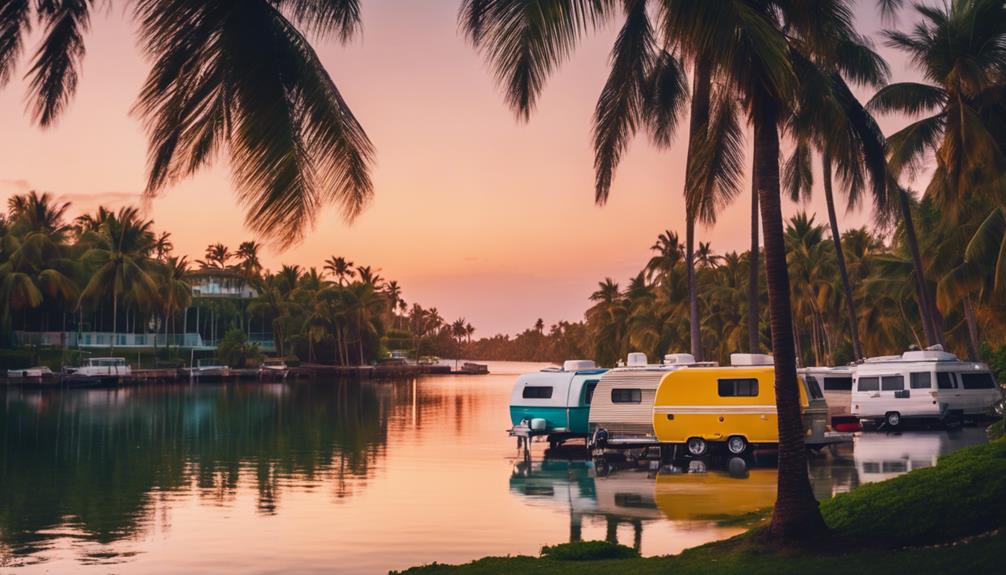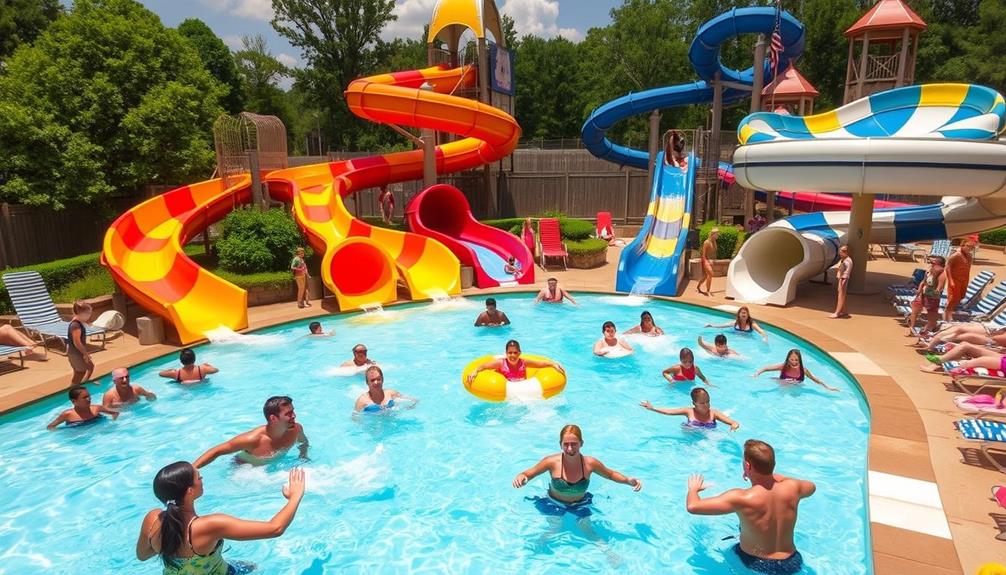Eco-friendly water parks are revolutionizing the leisure industry by integrating sustainability into every splash. You're seeing parks like Waterbom Bali achieve carbon neutrality while implementing innovative technologies that save water and energy. Many parks now utilize advanced filtration systems and renewable energy sources, drastically reducing their environmental impact. Initiatives like effective recycling programs and minimizing single-use plastics make visits more responsible and enjoyable. Even the landscaping focuses on native plants to conserve resources. If you're curious about more examples and the future of these sustainable havens, there's plenty more to explore on this growing trend in eco-conscious entertainment.
Key Takeaways
- Eco-friendly water parks prioritize sustainability by implementing practices that resonate with environmentally conscious consumers, driving increased visitor engagement.
- Advanced technologies, such as Variable Frequency Drives (VFDs) and energy-efficient lighting, significantly reduce energy consumption and water waste.
- Parks like Waterbom Bali and Wet'n'Wild Hawaii exemplify success through innovative waste reduction strategies and reliance on renewable energy sources.
- Community engagement initiatives, including local sourcing and recycling programs, enhance sustainability efforts while supporting local economies.
- The future of water parks is shaped by ambitious sustainability goals, including carbon neutrality and advanced resource management systems.
Importance of Sustainability in Water Parks
As climate change impacts our environment, the importance of sustainability in water parks becomes increasingly clear. You mightn't realize it, but your choice of where to spend your leisure time can greatly influence the environment.
Many water parks are now prioritizing sustainability, adopting eco-friendly practices that drastically reduce water and energy consumption. By implementing advanced filtration systems and variable frequency drives (VFDs), these parks can save up to 90% in water waste while enhancing energy efficiency.
Additionally, the integration of eco-friendly materials in construction and renovation reflects a commitment to minimizing environmental impact. The shift towards sustainability is evident in success stories like Waterbom Bali, which achieved carbon neutrality and minimized landfill waste through effective waste separation.
These initiatives not only improve the park's environmental impact but also resonate with consumers who value eco-conscious businesses. Furthermore, sustainable design practices focus on strategic planning, utilizing drought-resistant native plants and efficient water management systems to further reduce resource consumption.
Organizations like IAAPA play an essential role in this movement, offering resources and support to encourage water parks to adopt these sustainable practices.
Proven Sustainability Practices
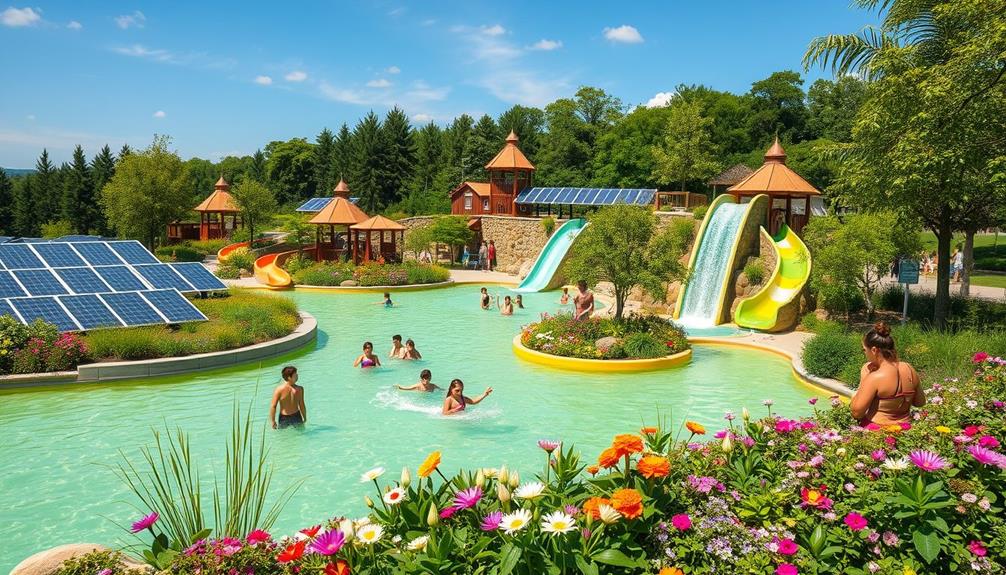
The shift toward sustainability in water parks not only highlights the importance of eco-friendly practices but also showcases proven methods that make a real difference. You can see the impact of sustainable initiatives through effective water efficiency technologies and energy conservation methods that are changing the landscape of water parks.
Here's a glimpse of some successful practices:
| Water Park | Proven Sustainability Practice |
|---|---|
| Waterbom Bali | Saved 54,000 cubic meters of water; 550,402 kilowatts power in 2019 |
| Sandcastle Waterpark | Achieved a 35% reduction in energy consumption |
| Variable Frequency Drives (VFDs) | Optimized pump operations, enhancing energy efficiency |
| Evoqua's Defender Filters | Minimized backwashing, improving water quality |
| Data Collection | Utilized water meters to track usage and evaluate success |
These parks are leading the way in water parks environmental stewardship. By integrating innovative filtration systems and efficient practices, they not only reduce energy but also inspire others to follow suit. Embracing these proven sustainability practices can create a ripple effect, promoting conservation that benefits everyone.
Innovative Technologies

You can transform your water park into a model of sustainability by adopting innovative technologies that focus on energy efficiency and advanced water filtration systems.
Implementing Variable Frequency Drives on pumps and energy-efficient LED lighting not only cuts down on power usage but also supports the park's eco-friendly mission.
Additionally, incorporating ozone air purifiers can help maintain clean and odor-free environments for guests, further enhancing the park's sustainability efforts.
Energy-Efficient Equipment Adoption
In today's eco-conscious landscape, water parks are increasingly embracing innovative technologies to enhance energy efficiency. The adoption of energy-efficient equipment not only reduces operational costs but also supports sustainable practices.
These advancements align with broader trends towards AI in Agriculture and Sustainability, showcasing how technology can benefit both the environment and business models. Here are some key advancements making a difference:
- Variable Frequency Drives (VFDs): These devices optimize pump operations, leading to notable reductions in power consumption.
- Energy-Efficient LED Lighting: Installing LED lights throughout the park cuts electricity consumption, helping achieve sustainability goals.
- Innovative Water Propulsion Systems: Technologies like blast propulsion can decrease pumping requirements by up to 60%, further promoting energy efficiency in attractions.
- Flow Meters with Regenerative Media Filters: This combination can yield up to 50% electrical savings, showcasing effective resource management.
Additionally, Evoqua's Defender pool filters minimize backwashing, improving water quality while conserving water and cutting energy usage during the filtration process.
By prioritizing energy-efficient equipment adoption, water parks can notably contribute to water conservation and overall sustainability, making your visit more enjoyable and eco-friendly.
Embracing these technologies is vital for the future of water parks and the environment.
Advanced Water Filtration Systems
With energy-efficient equipment laying the groundwork for sustainability, advanced water filtration systems are taking eco-friendly practices in water parks to the next level.
These systems, like Evoqua's Defender pool filters, minimize backwashing, greatly improving water quality and enhancing water efficiency. By integrating flow meters with regenerative media filters, water parks can achieve electrical savings of up to 50%, bolstering their energy conservation efforts.
Additionally, many of the best water parks in Washington DC are adopting similar technologies to enhance their environmental credentials.
Furthermore, adopting Variable Frequency Drives (VFDs) on pumps allows for substantial energy efficiency improvements, optimizing energy consumption linked to water filtration and circulation.
These innovative filtration technologies not only reduce energy use but also uphold rigorous water cleanliness standards, ensuring guest safety by eliminating 99.99% of microorganisms from the water.
Waste Reduction Strategies
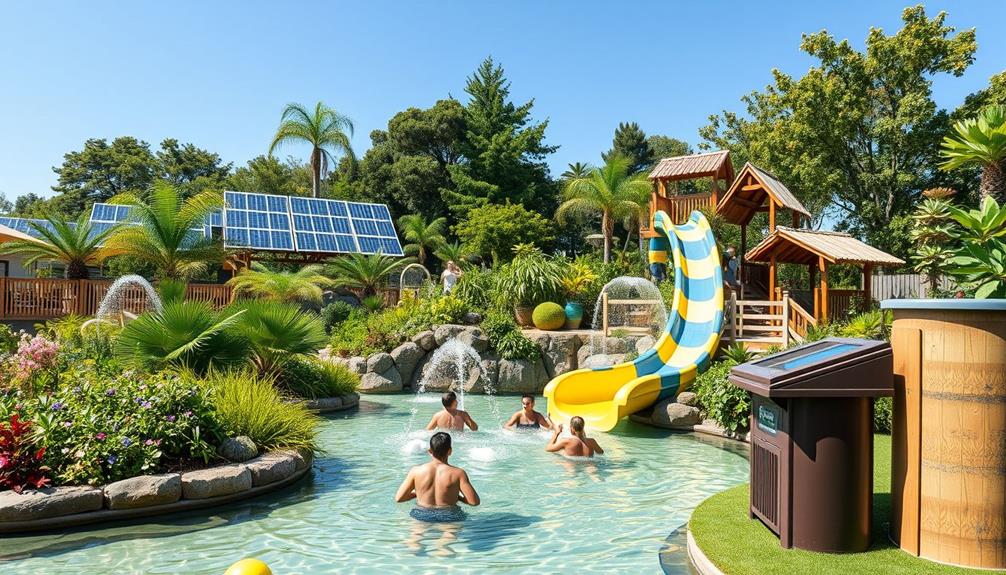
When you visit eco-friendly water parks, you'll notice their commitment to waste reduction through effective recycling programs.
Parks often incorporate sustainable materials in their design, similar to the use of natural materials in modern farmhouse decor. By cutting out single-use plastics, these parks create a cleaner environment for everyone.
Plus, sustainable landscaping practices not only beautify the area but also help minimize waste and conserve resources.
Recycling Program Implementation
Effective recycling program implementation is essential for minimizing waste at eco-friendly water parks. By creating a structured approach to recycling, you can greatly enhance guest participation and promote sustainability throughout the park. Here are some strategies to reflect upon:
1. Single-Stream Recycling: Simplifying recycling by allowing guests to combine recyclables into one bin encourages participation.
Additionally, focusing on products like safety glasses can also help in promoting eco-friendly practices within the park.
2. Park-Wide Initiatives: Implementing organized recycling efforts, like those at Waterbom Bali, can achieve impressive landfill waste reduction—up to 20%!
3. Sustainable Alternatives: Encourage the use of eco-friendly products in catering and retail operations, reducing reliance on single-use plastics.
4. Comprehensive Recycling Initiatives: Expand your recycling programs to include items like motor oils and cooking oils, further lessening your environmental impact.
Reducing Single-Use Plastics
Single-use plastics are a considerable contributor to environmental pollution, making their reduction a crucial goal for eco-friendly water parks. By implementing measures to eliminate these plastics in their catering and retail operations, water parks can greatly reduce waste and promote sustainability efforts.
Many parks, like Waterbom Bali, have achieved impressive results through park-wide waste separation initiatives. They reported a 20% reduction in landfill waste, showcasing the impact of reducing single-use plastics. Engaging guests in single-stream recycling programs further enhances participation and helps divert plastic waste from landfills, directly contributing to waste reduction.
Here's a quick overview of some effective strategies:
| Strategy | Impact | Example |
|---|---|---|
| Eliminate plastic straws | Reduces plastic waste | Use biodegradable options |
| Offer refillable drink cups | Less landfill waste | Encourage guest usage |
| Implement waste separation | Increases recycling rates | Park-wide initiatives |
These eco-friendly practices align with global sustainability goals and meet consumer expectations. By focusing on reducing single-use plastics, water parks can greatly lessen their environmental footprint and create a cleaner, greener future for everyone.
Sustainable Landscaping Practices
Sustainable landscaping practices in eco-friendly water parks play an essential role in reducing waste and enhancing environmental stewardship. By focusing on these approaches, you can greatly improve your park's ecological footprint.
For instance, implementing strategies that promote cat health and nutrition can also inspire sustainable practices in landscaping. Here are four effective strategies:
- Utilize Native Plants: These plants require less irrigation and create habitats that boost local biodiversity, reducing your overall environmental impact.
- Incorporate Natural Shade: By designing areas that provide natural shade, you can minimize water evaporation, leading to more efficient water management.
- Adopt Durable Materials: Using long-lasting landscaping materials helps extend the lifespan of your installations and aligns with waste reduction strategies.
- Promote Biodiversity: Implementing wildflower seed mixes not only decreases water and labor costs but also lessens the need for chemical treatments, protecting pollinator populations and enhancing ecosystem health.
Alternative Pest Control Approaches
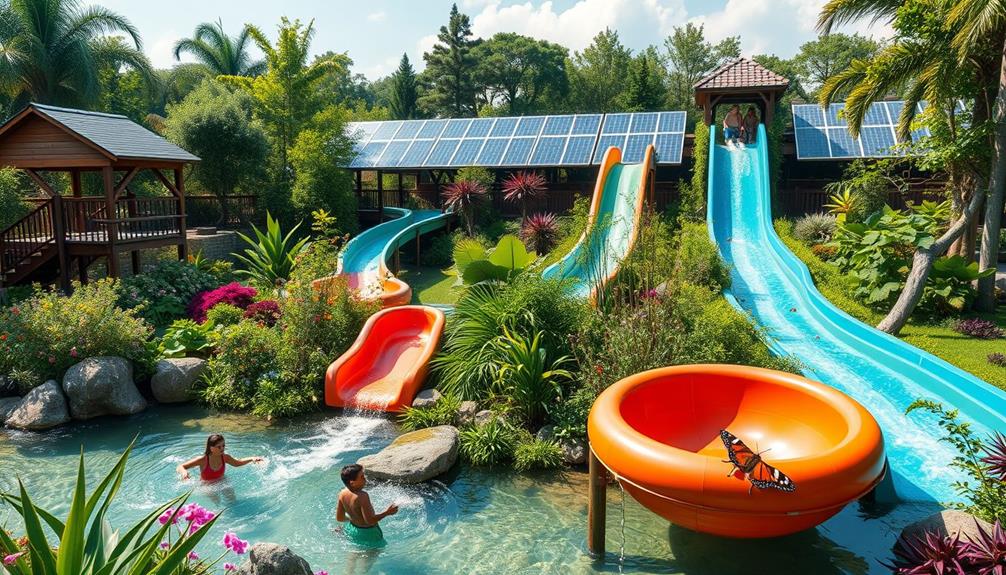
In recent years, water parks have increasingly turned to alternative pest control approaches to create a healthier environment for both guests and wildlife. By adopting chemical-free pest management solutions, like hiring specialists such as Mosquito Lady Consulting, parks are reducing chemical usage and promoting eco-friendly practices.
Additionally, just as pet owners must be mindful of toxic foods for dogs to guarantee their pets' safety, water parks are becoming more aware of the impact of chemicals on both the environment and public health.
Natural landscaping practices play a significant role in this movement. By incorporating native plants, water parks not only enhance biodiversity but also reduce irrigation needs, creating balanced ecosystems that can naturally deter pests.
These native plants provide habitats for beneficial organisms, further minimizing the reliance on chemical pest control.
Innovations like solar thermal paving systems are being explored for pool heating, contributing to a sustainable approach that helps decrease the need for chemical treatments.
Additionally, the study of non-chemical saline water purification methods supports these eco-friendly initiatives by addressing water treatment without the risks associated with chemical runoff.
Together, these alternative pest control approaches not only safeguard the environment but also guarantee a safe and enjoyable experience for guests, reinforcing the commitment of water parks to sustainability.
Community Engagement Initiatives
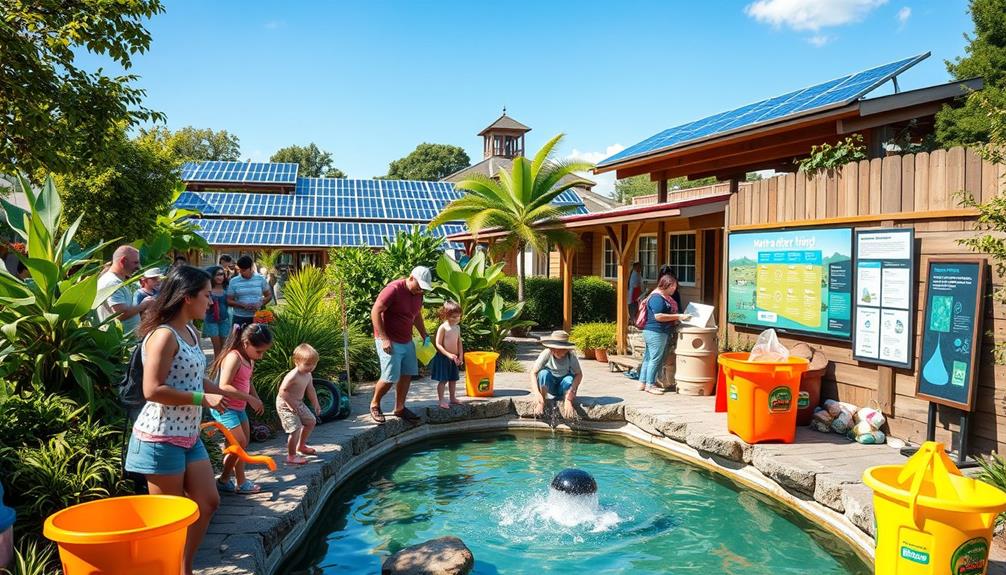
Many water parks are stepping up their community engagement initiatives to foster a sense of responsibility toward the environment and local economy.
These initiatives not only enhance local environmental impact but also actively involve guests and staff in sustainable practices.
Understanding the importance of emotional stability in community interactions, parks can benefit from supporting emotional management strategies.
Here are some effective strategies implemented by eco-friendly water parks:
- Local Sourcing: Many parks, like Center Parcs, source food and beverages from local farmers, bolstering local economies and reducing their carbon footprint.
- Recycling Programs: Guest-participation recycling programs encourage visitors to engage in sustainable practices, greatly improving recycling rates.
- Conservation Efforts: Parks like Atlantis Aquaventure donate proceeds from marine animal experiences to environmental causes, fostering community support for sustainability initiatives.
- Eco-Friendly Commuting Options: Offering amenities like bicycle rooms promotes sustainable transportation among employees, enhancing overall community engagement in environmental concerns.
Case Studies of Eco-Friendly Parks
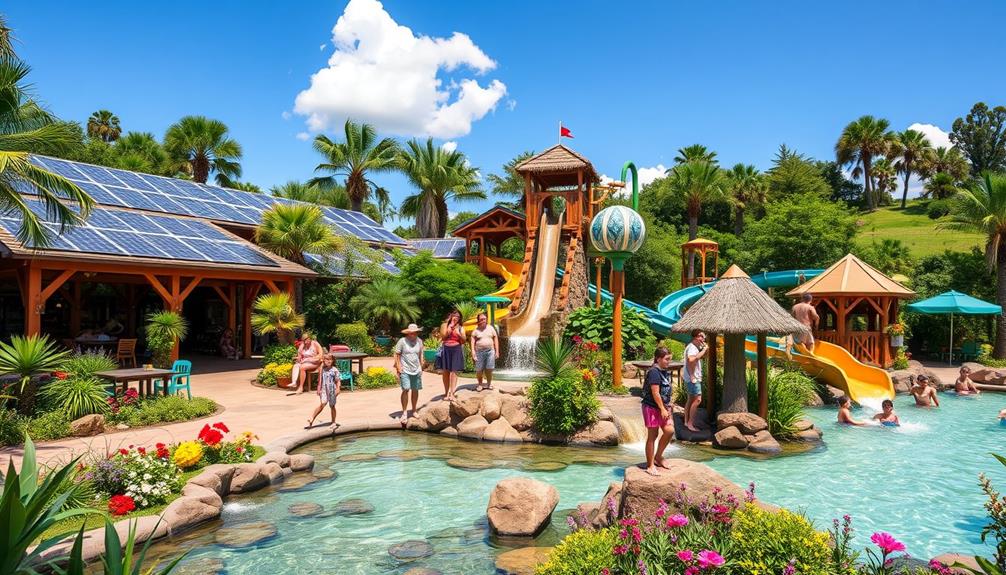
Eco-friendly water parks are setting impressive examples through their innovative practices and commitment to sustainability.
Take Waterbom Bali, for instance; it became the first tourism operation in Bali to achieve carbon neutrality. By implementing extensive drainage systems that recharge the water table, they're reducing runoff while achieving a 20% reduction in landfill waste through effective waste reduction initiatives.
Additionally, many parks are exploring renewable energy sources, such as geothermal energy production, to further minimize their environmental impact.
Wet'n'Wild Hawaii stands out as the first 100% solar-powered water park in Hawaii, utilizing 2,958 high-efficiency solar panels to generate 1.3 MW of power for its attractions.
Similarly, Six Flags Great Adventure showcases the potential for solar power in the water park industry, utilizing nearly 60,000 solar panels to provide 98% of its energy needs.
Center Parcs in the UK and Ireland exceeded their 20% carbon emission reduction goal two years early, setting a new target of 30% by 2030, focusing on renewable energy.
Finally, Atlantis Aquaventure has made strides in water management by replacing non-native plants with drought-tolerant species, achieving EarthCheck Silver certification.
These eco-friendly parks demonstrate how sustainability practices can effectively reduce carbon emissions and promote a greener future.
Future of Sustainable Water Parks

The future of sustainable water parks looks promising as operators embrace innovative technologies and practices to meet growing consumer demand for eco-friendly attractions.
Here are four key trends shaping this future:
- Enhanced Energy Efficiency: Using Variable Frequency Drives (VFDs) can optimize energy consumption, leading to significant savings.
- Reduced Water Usage: Advanced filtration methods and blast propulsion systems help achieve up to 60% water flow reductions.
- Commitment to Carbon Neutrality: Parks like Waterbom Bali set ambitious sustainability goals, adopting environmental management systems to guarantee their operations align with eco-friendly practices.
- Collaboration for Best Practices: Organizations like MENALAC promote resource-sharing and recognition for parks excelling in sustainability and innovation.
As these water parks implement these innovations, you'll likely see a rise in the overall sustainability of the industry.
The focus on energy efficiency and responsible water usage won't only enhance the guest experience but also contribute positively to the environment.
Frequently Asked Questions
What Initiatives for Sustainability Could We Start With Water?
You can start with initiatives like installing low-flow fixtures, implementing advanced filtration systems, and utilizing native plants for landscaping. These steps conserve water, reduce costs, and promote sustainability in your operations effectively.
What Are Some Sustainable Practices Used by Parks to Help Promote Sustainable Practices?
Sustainable parks showcase smart strategies, like solar solutions and savvy systems. You'll see water conservation, energy efficiency, and environmental certifications promoting planet-friendly practices. These efforts not only conserve resources but also enhance your experience.
How to Make Theme Parks More Sustainable?
To make theme parks more sustainable, you can implement advanced filtration systems, use energy-efficient lighting, install low-flow fixtures, promote recycling, and eliminate single-use plastics, all while engaging guests in eco-friendly practices and initiatives.
Is Water Conservation Sustainable?
Water conservation's not just sustainable; it's essential. You're saving resources while ensuring future generations enjoy clean water. With smart practices, you're balancing enjoyment and responsibility, proving that fun and sustainability can coexist beautifully.
Conclusion
As you immerse yourself in the world of eco-friendly water parks, you'll find a revitalizing blend of fun and responsibility. While thrilling slides entice adventurers, sustainable practices guarantee a brighter future for our planet. The balance between enjoyment and environmental care proves that you don't have to sacrifice one for the other. By supporting these innovative parks, you're not just making a splash; you're championing a movement towards greener, healthier leisure experiences for everyone. These parks often incorporate cutting-edge technologies, such as energy-efficient water filtration systems and solar-powered operations, to minimize their environmental impact. By aligning water parks and conservation efforts, they set an inspiring example of how leisure and sustainability can work hand in hand. Visiting these destinations is more than just entertainment—it’s an investment in a sustainable legacy for future generations.


